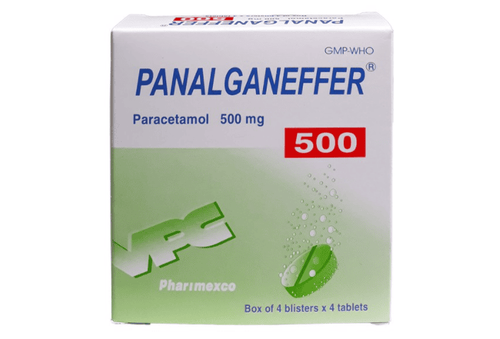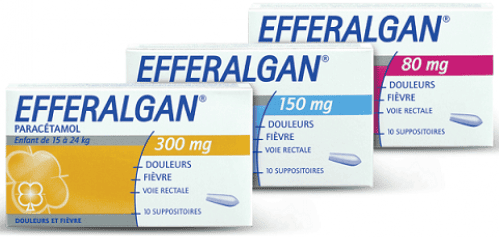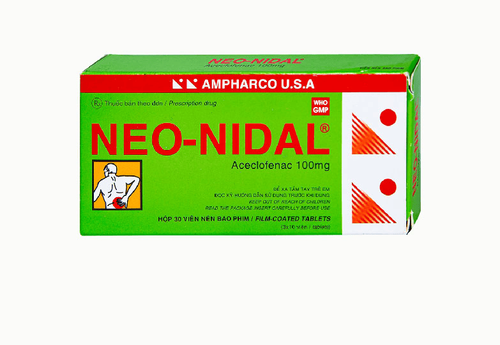This is an automatically translated article.
Panalganeffer contains the active ingredient paracetamol, a well-known antipyretic pain reliever. Because the drug is quite popular and easy to buy, it is easy to abuse and lead to many dangerous side effects. The article will provide readers with information on usage, dosage and important notes when using the drug.
1. What is Panalganeffer?
Panalganeffer contains the main active ingredient paracetamol with different strengths such as 80mg, 150mg, 250mg and 500mg. Paracetamol is a popular pain reliever and fever reducer. The drug acts on the thermoregulatory center in the hypothalamus causing vasodilation and increased peripheral blood flow, reducing body temperature, thereby increasing heat production and reducing fever in febrile patients. At therapeutic doses, paracetamol has little effect on the cardiovascular and respiratory systems, does not change the acid-base balance, does not affect platelet aggregation and does not irritate the stomach.
Paracetamol is rapidly and almost completely absorbed after oral administration. The half-life of the drug is 1.25 - 3 hours. The drug is metabolised mainly in the liver and is eliminated by the kidneys as unchanged drug and also as metabolites.
2. Uses of the drug panalganeffer
Panalganeffer medicine has the effect of reducing fever and pain. It is commonly used to reduce fever and treat mild to moderate pain (headache, backache, menstrual cramps, toothache, flu, colds, etc.). Note that the drug is not used to treat pain caused by rheumatism or pain of visceral origin.

Thuốc panalganeffer 500 có công dụng hạ sốt và giảm đau
3. Usage and dosage
How to use: Because the drug is in the form of effervescent tablets, it should be mixed with water until the drug is completely dissolved. Dosage for adults and children from 12 years of age and older: 1 tablet of panalganeffer 500mg/time or can use 2 tablets of 500mg/time as needed. If pain or fever is still present, the patient can continue taking the drug, but keep in mind that the interval between 2 doses is 4-6 hours. Note: Patients should not use many products containing paracetamol at the same time because it can lead to overdose and many dangerous side effects.
4. What to do in case of paracetamol overdose?
First signs of paracetamol overdose, including loss of appetite, nausea, vomiting, stomach pain, sweating, confusion or weakness. Later symptoms may include: upper abdominal pain, dark urine, yellowing of the skin or whites of the eyes. When overdose of paracetamol, you need to immediately go to the nearest medical facility for timely treatment.
5. Undesirable effects of the drug panalganeffer
Hepatotoxicity: Acute hepatotoxicity may result from intentional or unintentional overdose in adult and pediatric patients. In pediatric patients, unintentional overdose may be caused by accidental ingestion, taking the drug more often than recommended, and using multiple products containing acetaminophen. Some risk factors increase the toxicity of paracetamol on the liver including: the elderly, alcoholism, using many products containing paracetamol. Dermatology: Skin rash, bullae, skin rash Nausea, vomiting Anorexia, abdominal pain Neutropenia, anemia. Hearing loss

Buồn nôn, nôn là tác dụng không mong muốn của thuốc panalganeffer
6. Notes when using panalganeffer medicine
When using Panalganeffer, you should note:
Patients with G6PD deficiency: Use caution when using the drug for patients who already have G6PD deficiency. Hepatic impairment: Use with caution in patients with hepatic impairment or active liver disease. In rare cases, Panalganeffer can cause serious skin reactions such as Stevens-Johnson syndrome, toxic epidermal necrolysis, acute generalized pustular syndrome. When there are signs such as skin redness, rash, peeling, the patient needs to stop the drug immediately and go to the nearest medical facility. Pregnancy: Paracetamol crosses the placenta. Based on current data, there is no increased risk of major birth defects following maternal use of paracetamol during pregnancy. The use of acetaminophen in normal doses during pregnancy does not increase the risk of miscarriage or stillbirth. However, an increase in fetal death or spontaneous abortion after maternal overdose may be seen if treatment is delayed. In summary, paracetamol is considered appropriate for the treatment of pain and fever during pregnancy. Paracetamol is recommended to be used at the lowest effective dose and for the shortest time to treat the mother and protect the health of the fetus. Lactation: Paracetamol appears in breast milk. The drug is considered safe for breastfeeding women when used in normally recommended doses. Paralganeffer does not affect the ability to drive or use machines. Therefore, patients can use it with confidence. There are many other drugs that can interact with paracetamol. Therefore, you need to tell your doctor or pharmacist about all prescription and over-the-counter medicines, vitamins and minerals, and herbal products you are taking. Medicines should be stored in a cool, dry place and out of direct sunlight. In case you notice that the drug appears strange signs such as discoloration, watering, deformation, you should not use it. In short, panalganeffer is the "national" antipyretic analgesic. You can easily buy medicine at many drugstores nationwide. However, the drug can cause many dangerous side effects such as hepatotoxicity, liver necrosis and even death if overdosed. Therefore, patients should not abuse the drug and should consult a doctor or pharmacist for long-term use.
Follow Vinmec International General Hospital website to get more health, nutrition and beauty information to protect the health of yourself and your loved ones in your family.
Please dial HOTLINE for more information or register for an appointment HERE. Download MyVinmec app to make appointments faster and to manage your bookings easily.













